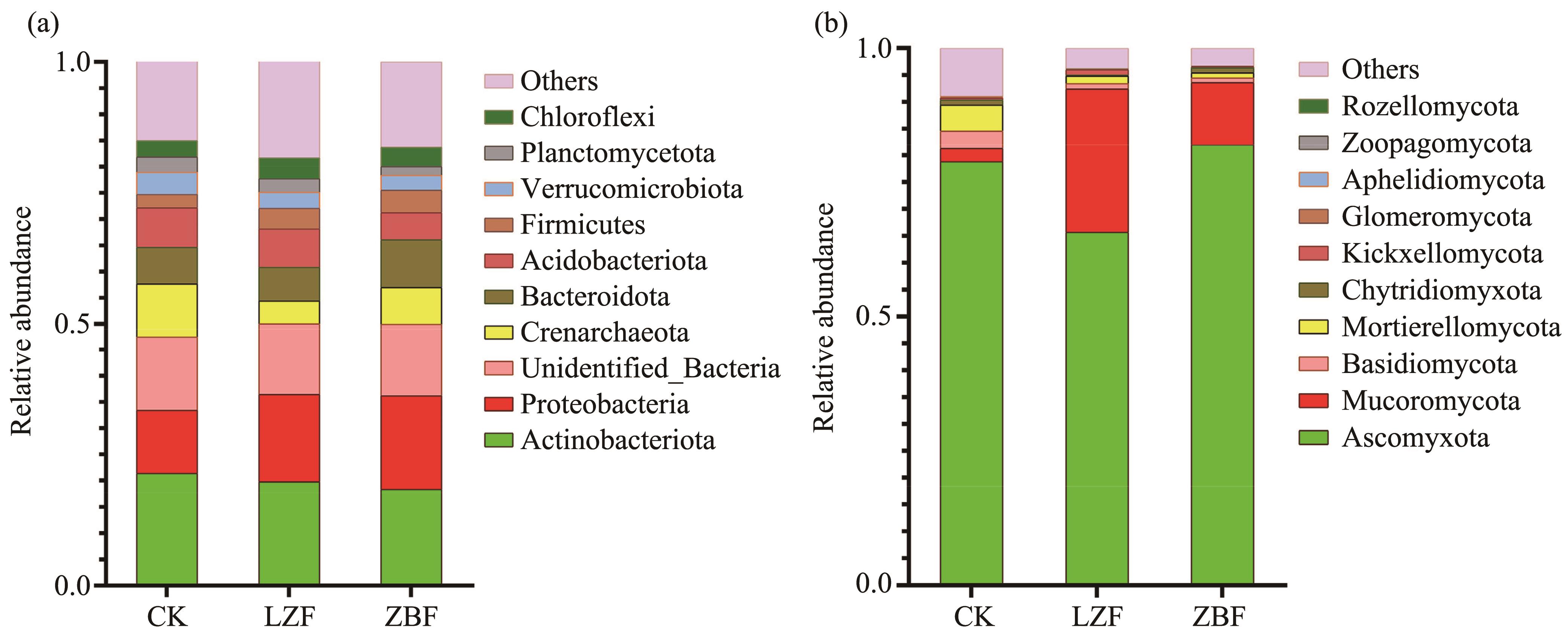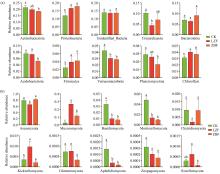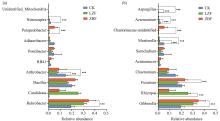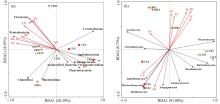Sciences in Cold and Arid Regions ›› 2022, Vol. 14 ›› Issue (3): 212–222.doi: 10.3724/SP.J.1226.2022.21056.
• • 上一篇
Decomposition effects of Lanzhou lily (Lilium davidii var. unicolor) flowers on soil physical and chemical properties and microbial community diversity
Jie Li1,2,YaJun Wang1( ),Yang Qiu1,ZhongKui Xie1,YuBao Zhang1,CuiPing Hua1,2
),Yang Qiu1,ZhongKui Xie1,YuBao Zhang1,CuiPing Hua1,2
- 1.Northwest Institute of Eco-Environment and Resources, Chinese Academy of Sciences, Lanzhou, Gansu 730000, China
2.University of Chinese Academy of Sciences, Beijing 100049, China
|
An LZ, Zou B, Ding Y, et al., 2004. Key factors of forest litter decomposition and research progress. Chinese Journal of Ecology, 06: 77-83. DOI: CNKI:SUN:STXZ.0.2004-06-016 .
doi: CNKI:SUN:STXZ.0.2004-06-016 |
|
|
Andersson M, KjLler A, Struwe S, 2004. Microbial enzyme activities in leaf litter, humus and mineral soil layers of European forests. Soil Biology & Biochemistry,10(36): 1527-1537. DOI: 10.1016/j.soilbio.2004.07.018 .
doi: 10.1016/j.soilbio.2004.07.018 |
|
|
Batish DR, Singh HP, Pandher JK, et al., 2010. Phytotoxic effect of Parthenium residues on the selected soil properties and growth of chickpea and radish. Weed Biology & Management, 2(2): 73-78. DOI: 10.1046/j.1445-6664.2002. 00050.x .
doi: 10.1046/j.1445-6664.2002. 00050.x |
|
|
Bian XR, Shi GY, Liang QL, et al., 2016. Isolation and identification of wilt disease pathogen from Lanzhou lily and its pathogenicity. Journal of Gansu Agricultural University, 4(51): 58-64. DOI: 10.13432/j.cnki.jgsau.2016.04.010 .
doi: 10.13432/j.cnki.jgsau.2016.04.010 |
|
|
Bocock KL, Gilbert O, 1957. The disappearance of leaf litter under different woodland conditions. Plant & Soil, 2(9): 179-185. DOI: 10.1007/BF01398924 .
doi: 10.1007/BF01398924 |
|
|
Bonfante P, Venice F, 2020. Mucoromycota: going to the roots of plant-interacting fungi. Fungal Biology Reviews, 2(34): 100-113. DOI: 10.1016/j.fbr.2019.12.003 .
doi: 10.1016/j.fbr.2019.12.003 |
|
| Chapin FS, Matson PA, Mooney HA, 2011. Principles of Terrestrial Ecosystem Ecology. Springer. | |
| Chen JL, Sun HQ, Fan SF, et al., 2016. Effect of root exudates from Lanzhou lily on allelopathy of lily seedlings. Journal of Gansu Agricultural University, 6(51): 64-69. | |
| Chen LD, 2009. Effect of different bud picking time on Lily bulb yield. Modern Agricultural Science and Technology, 15: 73-75. | |
|
Edgar RC, 2013. UPARSE: highly accurate OTU sequences from microbial amplicon reads. Nature Methods, 10(10): 996. DOI: 10.1038/NMETH.2604 .
doi: 10.1038/NMETH.2604 |
|
|
Gao YY, Weiguo C, Jindi Z, et al., 1990. Experimental study on increasing yield of Lilium davidii by removing flowers. Gansu Agricultural Science and Technology, 10: 14-16. DOI: CNKI: SUN: GSNK.0.1990-10-006 .
doi: CNKI: SUN: GSNK.0.1990-10-006 |
|
| Geng Q, 2014. A Study on Leaf Litter Decomposition in Ginkgo biloba Agroforestry Systems. Nanjing Forestry University. . | |
|
Guo ZL, Zheng JP, Ma YD, et al., 2006. Researches on litterfall decomposition rates and model simulating of main species in various forest vegetations of Changbai Mountains, China. Acta Ecological Sinica, 4(26): 1037-1046. DOI: 10. 3321/j.issn:1000-0933.2006.04.009 .
doi: 10. 3321/j.issn:1000-0933.2006.04.009 |
|
|
Haas BJ, Gevers D, Earl AM, et al., 2011. Chimeric 16S rRNA sequence formation and detection in Sanger and 454-pyrosequenced PCR amplicons. Genome Research, 3(21): 494-504. DOI: 10.1101/gr.112730.110 .
doi: 10.1101/gr.112730.110 |
|
| He MH, He YJ, Wu CY, et al., 2019. Effects of rocky desertification intensity on soil fungal composition and diversity during karst vegetation succession. Mycosystema, 4(38): 471-484. | |
|
Hua CP, Wang YJ, Xie ZK, et al., 2018. Effects of intercropping on rhizosphere soil microorganisms and root exudates of Lanzhou lily (Lilium davidii var. unicolor). Sciences in Cold and Arid Regions, 10(2): 159-168. DOI: 10.3724/SP.J.1226.2018.00159 .
doi: 10.3724/SP.J.1226.2018.00159 |
|
|
Jia BR, 2019. Litter decomposition and its underlying mechanisms. Chinese Journal of Plant Ecology, 43(8): 648-657. DOI:10.17521/cjpe.2019.0097 .
doi: 10.17521/cjpe.2019.0097 |
|
|
Li HT, Yu GR, Li JY, et al., 2007. Decomposition dynamics and nutrient release of litters for four artificial forests in the red soil and hilly region of subtropical China, Acta Ecological Sinica. DOI: 10.3321/j.issn:1000-0933.2007.03.009 .
doi: 10.3321/j.issn:1000-0933.2007.03.009 |
|
|
Li SS, Wang ZW, Yang JJ, 2016. Changes in soil microbial communities during litter decomposition. Biodiversity Science, 2(24): 195-204. DOI: 10.17520/biods.2015149 .
doi: 10.17520/biods.2015149 |
|
|
Lin B, Liu Q, Wu Y, et al., 2004. Advances in the studies of forest litter. Chinese Journal of Ecology, 23(1): 60-64. DOI: CNKI: SUN: STXZ.0.2004-01-013 .
doi: CNKI: SUN: STXZ.0.2004-01-013 |
|
|
Lü WC, Qiu Y, Xie Z, et al., 2019. Gravel mulching effects on soil physicochemical properties and microbial community composition in the Loess Plateau, northwestern China. European Journal of Soil Biology, 94: 103-115. DOI: 10. 1016/j.ejsobi.2019.103115 .
doi: 10. 1016/j.ejsobi.2019.103115 |
|
|
Magoč T, Salzberg SL, 2011. FLASH: fast length adjustment of short reads to improve genome assemblies. Bioinformatics, 27(21): 2957-2963. DOI: 10.1093/bioinformatics/btr507 .
doi: 10.1093/bioinformatics/btr507 |
|
|
Melin E, 1930. Biological decomposition of some types of litter from North American Forests. Ecology, 1(11): 72-101. DOI: 10.2307/1930782 .
doi: 10.2307/1930782 |
|
|
Mo JM, Kong GH, Brown S, 2001. Litterfall response to human impacts in a dinghushan pine forest. Acta Photogeological Sinica, 6(25): 656-664. DOI: 10.1088/0256-307X/18/11/313 .
doi: 10.1088/0256-307X/18/11/313 |
|
|
Moharana PC, Sharma BM, Biswas DR, et al., 2012. Long-term effect of nutrient management on soil fertility and soil organic carbon pools under a 6-year-old pearl millet-wheat cropping system in an Inceptisol of subtropical India. Field Crops Research, (136): 32-41. DOI: 10.1016/j.fcr.2012. 07.002 .
doi: 10.1016/j.fcr.2012. 07.002 |
|
|
Purahong W, Wubet T, Lentendu G, et al., 2016. Life in leaf litter: novel insights into community dynamics of bacteria and fungi during litter decomposition. Molecular Ecology, 25(16): 4059-4074. DOI: 10.1111/mec.13739 .
doi: 10.1111/mec.13739 |
|
|
Qiu Y, Lv WC, Wang XP, et al., 2020. Long-term effects of gravel mulching and straw mulching on soil physicochemical properties and bacterial and fungal community composition in the Loess Plateau of China. European Journal of Soil Biology, 98: 103188. DOI: https://doi.org/10.1016/j.ejsobi.2020.103188 .
doi: 10.1016/j.ejsobi.2020.103188 |
|
|
Qiu Y, Xie Z, Wang X, et al., 2018. Effect of slow-release iron fertilizer on iron-deficiency chlorosis, yield and quality of Lilium davidii var. unicolor in a two-year field experiment. Sciences in Cold and Arid Regions, 5(10): 421-427. DOI: CNKI: SUN: HAQK.0.2018-05-008 .
doi: CNKI: SUN: HAQK.0.2018-05-008 |
|
|
Quast C, Pruesse E, Yilmaz P, et al., 2012. The SILVA ribosomal RNA gene database project: Improved data processing and web-based tools. Nucleic Acids Research, 41(D1): 590-596. DOI: 10.1093/nar/gks1219 .
doi: 10.1093/nar/gks1219 |
|
|
Shang Q, Yang G, Wang Y, et al., 2016. Illumina-based analysis of the rhizosphere microbial communities associated with healthy and wilted Lanzhou lily (Lilium davidii var. unicolor) plants grown in the field. World Journal of Microbiology & Biotechnology, 6(32): 1-15. DOI: 10.1007/s11274-016-2051-2 .
doi: 10.1007/s11274-016-2051-2 |
|
|
Shen Y, 2010. Responses of Litter Production Decomposition in Wheat Cultivars to Soil Nutrients in Their Habitats. Henan Agricultural University. DOI: https://kns.cnki.net/KCMS/detail/detail.aspx
doi: https://kns.cnki.net/KCMS/detail/detail.aspx |
|
| Southwest AU, 1980. Southern Edition of Soil Science (2nd Edition): China Agriculture Press. | |
|
Sun X, Long G, Zhang G, et al., 2015. Properties of soil physical-chemistry and activities of soil enzymes in context of continuous cropping obstacles for panax notoginseng. Ecology and Environmental Sciences, 3(24): 409-417. DOI: 10.16258/j.cnki.1674-5906.2015.03.007 .
doi: 10.16258/j.cnki.1674-5906.2015.03.007 |
|
|
Swift MJ, Heal OW, Anderson JM, 1979. Decomposition in terrestrial ecosystems. Studies in Ecology, 14(5): 2772-2774. DOI: 10.1063/1.1615673 .
doi: 10.1063/1.1615673 |
|
|
Tenney FG, Waksman SA, 1929. Composition of natural organic materials and their decomposition in the soil: IV. the nature and rapidity of decomposition of the various organic complexes in different plant materials, under aerobic conditions. Soil Science, 1(28): 55. DOI: 10.1097/00010694-192907000-00005 .
doi: 10.1097/00010694-192907000-00005 |
|
| Wang FY, 1989. Review on the study of forest litterfall. Advances in Ecology, 2(6): 82-89. | |
|
Wang Q, 2007. Naive Bayesian classifier for rapid assignment of rRNA sequences into the new bacterial taxonomy. Applied and Environmental Microbiology, (73): 5261-5267. DOI: 10.1128/AEM.00062-07 .
doi: 10.1128/AEM.00062-07 |
|
| Wang SL, 2010. Forest litter ecology. Chinese Journal of Eco-Agriculture, 04(18): 757. | |
|
Wang SL, Wang MX, 2002. The several thoughts and suggestions to the industrial development of Lanzhou-lily bulb. Journal of Gansu Agricultural University, 1(37): 82-81. DOI: 10.1007/s11769-002-0038-4 .
doi: 10.1007/s11769-002-0038-4 |
|
|
Wang SQ, Yu GR, 2008. Ecological stoichiometry characteristics of ecosystem carbon, nitrogen and phosphorus elements. Acta Ecological Sinica, 8: 3937-3947. DOI: 10. 3321/j.issn:1000-0933.2008.08.054 .
doi: 10. 3321/j.issn:1000-0933.2008.08.054 |
|
|
Wang X, 2012. Studies on the Litter Decomposition Characteristic of Larix Princicpis-rupprechtii Mayr. Plantation in Yanshan Mountainous Regions. Hebei Agricultural University. DOI: https://kns.cnki.net/kcms/detail/detail.aspx
doi: https://kns.cnki.net/kcms/detail/detail.aspx |
|
|
Wang YF, 2013. The influence of litter mixing on decomposition and soil fauna assemblages in a Pinus koraiensis mixed broad-leaved forest of the Changbai Mountains, China. European Journal of Soil Biology, (55): 28-39. DOI: 10.1016/j.ejsobi.2012.11.004 .
doi: 10.1016/j.ejsobi.2012.11.004 |
|
| Wang YY, Guo DF, 2016. Fungal diversity of saline alkali soil in Yellow River delta. Northern Horticulture, 18: 185-189. | |
|
Wu ZJ, Liu Y, Ruoyu W, et al., 2015. In vitro study of the growth, development and pathogenicity responses of Fusarium oxysporum to phthalic acid, an autotoxin from Lanzhou lily. World Journal of Microbiology & Biotechnology, 1227-1234. DOI: 10.1007/s11274-015-1872-8 .
doi: 10.1007/s11274-015-1872-8 |
|
| Wu ZJ, Xie ZK, Yang L, et al., 2015. Identification of autotoxins from root exudates of Lanzhou lily (Lilium davidii var. unicolor). Allelopathy Journal, 1(35): 35-48. | |
| Xu Q, Qian X, Gui Z, 1998. Effects of litter decomposition of different stands on soil properties. Journal of Zhe-jiang Forestry College, 1: 29-33. | |
|
Ye RH, Shan YM, Zhang PJ, et al., 2020. Effects of nitrogen and water addition on litter decomposition in desert grassland under different grazing intensities. Acta Ecological Sinica, 8(40): 2775-2783. DOI: 10.5846/stxb201902110245 .
doi: 10.5846/stxb201902110245 |
|
| Yu M, Wo Y, Gen C, et al., 2004. Agrochemical characteristics of soil for continuous cropping Lily. Chinese Journal of Soil Science, 3: 377-379. | |
|
Yue KX, Gong JR, Yu SY, et al., 2020. Effects of litter quality and soil enzyme activity on litter decomposition rate in typical grassland subject to nitrogen addition. Acta Protoculture Sinica, 6(29): 71-82. DOI: 10.11686/cyxb2019417
doi: 10.11686/cyxb2019417 |
|
|
Zhang J, 2015. Microbial Diversity of Soil Infected by Meloidogyne Spp. Yunnan University. DOI: https://kns.cnki.net/KCMS/detail/detail.aspx
doi: https://kns.cnki.net/KCMS/detail/detail.aspx |
|
| Zhang Q, Song Y, You W, 1999. Dynamics of litter amount and its decomposition in different successional stages of evergreen broad-leaved forest in Tiantong, Zhejiang province. Acta Phytoecologica Sinica, 3: 59-64. | |
|
Zhang Y, Wang Y, Xie Z, et al., 2018. The occurrence and distribution of viruses infecting Lanzhou lily in northwest, China. Crop Protection, 110: 73-76. DOI: 10.1016/j.cropro. 2018.02.028 .
doi: 10.1016/j.cropro. 2018.02.028 |
|
|
Zhao XY, Cui JY, Zhang TH, 1999. Estimation and dynamic modeling of wheat litter production in decertified arable land in Horqin Sandy Land. Journal of Desert Research, 19(3): 103-106. DOI: CNKI: SUN: ZGSS.0.1999-S1-023 .
doi: CNKI: SUN: ZGSS.0.1999-S1-023 |
|
| Zhao YY, Xie ZK, Hu BA, et al., 2018. Production status and benefits analysis of Lanzhou Lily. China Vegetables, 2: 71-75. | |
|
Zheng LY, Hu JF, Lin CH, et al., 2005. The production of succession cropping obstacles and its prevention and cure steps. Chinese Journal of Tropical Agriculture, 2(5): 58-62. DOI: CNKI:SUN:RDNK.0.2005-02-015 .
doi: CNKI:SUN:RDNK.0.2005-02-015 |
| No related articles found! |
|
||








